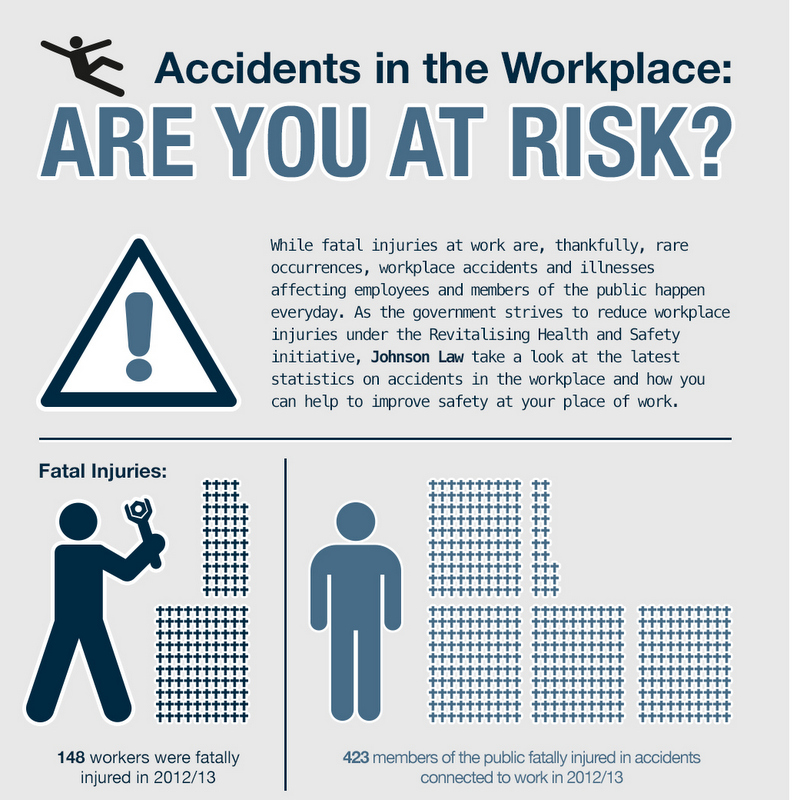
How building industry employers can reduce the risks of accidents
Raising awareness of everyday risks in the workplace
With the government’s Revitalising Health and Safety initiative underway, personal injury specialists Johnson Law are working to raise awareness of the everyday risks within the workplace, and offer advice on how employers reduce the risks to staff.
They have produced this infographic which highlights some interesting facts surrounding workplace safety.
It shows that in 2012/13, 148 people were fatally injured at work, while a further 423 members of the public were also fatally injured in accidents connected to work.
While workplace deaths are rare, injuries occur every day, and due to the nature of the building industry, those in it are at particular risk.
In fact, a quarter of all workplace deaths happen in the construction industry a staggering statistic considering that only 5 per cent of the population works in construction.
The most common causes of injuries include:
- Trips/slips or falls
- Electrical incidents
- Manual lifting
Such incidents can lead to serious back, head and neck injuries. Less common, but still a risk on site, are hearing problems and vibration white finger.
In the UK, 2million people believe that their current or a previous job has caused or exacerbated an illness. The cost of this runs into billions of pounds and millions of lost working days.
To help protect your workforce from accidents you should take the following preventative steps:
- Evaluate the potential risks at work and identify individuals at risk
- Consider the severity and likelihood of risks and address them in order of priority
- Implement a safety plan, communicate it to staff and ensure it is always up to date
- Make sure you report any accidents, work-related diseases and dangerous incidents to the Health and Safety Executive or local authority.
Workplace injury and illness cases prosecuted by HSE
In 2010, 551 workplace injury and illness cases were prosecuted by the HSE in England and Wales. By taking these steps you can protect your workforce from harm, and yourself from legal action.
If as an employee you feel that your health or safety are at risk you should raise the issue with your employer. They have a duty to take action that will protect you.
SEND YOUR COMMENTS TO BUILDINGTALK
READ MORE HOT TOPICS
Johnson Law,
29-31 Knowsley Street,
Bolton,
United Kingdom,
BL1 2AS
Phone: 0800 130 0699
Fax: 01204 520 777
Visit Supplier's page
Latest news

21st February 2025
ASSA ABLOY EMEIA: Save valuable time and money with a seamless switch to programmable digital keys
In 2025, access management can be a whole lot easier. By making access part of their digital processes, businesses can put time-consuming key management and the cost of changing the locks firmly behind them. Making this switch is a lot easier than many people think, as ASSA ABLOY explains here…
Posted in Access Control & Door Entry Systems, Architectural Ironmongery, Articles, Building Industry News, Building Products & Structures, Building Services, Doors, Facility Management & Building Services, Health & Safety, Information Technology, Innovations & New Products, Retrofit & Renovation, Security and Fire Protection
21st February 2025
Showersave supports industry leaders in addressing Part L and Part G regulations
Showersave has sponsored and participated in a recent Building Insights LIVE roundtable on ‘Water & Energy Saving Innovations in New Build Housing’.
Posted in Articles, Bathrooms & Toilets, Bathrooms, Bedrooms & Washrooms, Building Associations & Institutes, Building Industry Events, Building Industry News, Building Products & Structures, Building Regulations & Accreditations, Building Services, Exhibitions and Conferences, Interiors, Pipes & Fittings, Plumbing, Retrofit & Renovation, Sustainability & Energy Efficiency
21st February 2025
GEZE: The importance of Specifying High Quality Door Closers on Fire Doors
Andy Howland, Sales & Marketing Director at GEZE UK, discusses why specifying high quality door closers on fire doors is important…
Posted in Access Control & Door Entry Systems, Accessibility, Architectural Ironmongery, Articles, Building Industry News, Building Products & Structures, Building Regulations & Accreditations, Building Services, Doors, Facility Management & Building Services, Health & Safety, Posts, Restoration & Refurbishment, Retrofit & Renovation, Security and Fire Protection
21st February 2025
Insight Data achieves ISO9001 recertification with zero non-conformities
Leading industry data specialist, Insight Data, has successfully achieved the prestigious recertification for ISO9001 with zero non-conformities for the fourth consecutive year.
Posted in Articles, Building Industry News, Building Regulations & Accreditations, Building Services, Information Technology, Research & Materials Testing
 Sign up:
Sign up: